Single channel properties of rat acid-sensitive ion channel-1alpha, -2a, and -3 expressed in Xenopus oocytes
- PMID: 12356856
- PMCID: PMC2229538
- DOI: 10.1085/jgp.20028574
Single channel properties of rat acid-sensitive ion channel-1alpha, -2a, and -3 expressed in Xenopus oocytes
Abstract
The mammalian nervous system expresses proton-gated ion channels known as acid-sensing ion channels (ASICs). Depending on their location and specialization some neurons express more than one type of ASIC where they may form homo- or heteromeric channels. Macroscopic characteristics of the ASIC currents have been described, but little is known at the single channel level. Here, we have examined the properties of unitary currents of homomeric rat ASIC1alpha, ASIC2a, and ASIC3 expressed in Xenopus oocytes with the patch clamp technique. We describe and characterize properties unique to each of these channels that can be used to distinguish the various types of ASIC channels expressed in mammalian neurons. The amplitudes of the unitary currents in symmetrical Na(+) are similar for the three types of channels (23-18 pS) and are not voltage dependent. However, ASIC1alpha exhibits three subconductance states, ASIC2a exhibits only one, and ASIC3 none. The kinetics of the three types of channels are different: ASIC1alpha and ASIC2a shift between modes of activity, each mode has different open probability and kinetics. In contrast, the kinetics of ASIC3 are uniform throughout the burst of activity. ASIC1alpha, ASIC2a, and ASIC3 are activated by external protons with apparent pH(50) of 5.9, 5.0, and 5.4, respectively. Desensitization in the continual presence of protons is fast and complete in ASIC1alpha and ASIC3 (2.0 and 4.5 s(-1), respectively) but slow and only partial in ASIC2a (0.045 s(-1)). The response to external Ca(2+) also differs: micro M concentrations of extracellular Ca(2+) are necessary for proton gating of ASIC3 (EC(50) = 0.28 micro M), whereas ASIC1alpha and ASIC2a do not require Ca(2+). In addition, Ca(2+) inhibits ASIC1alpha (K(D) = 9.2 +/- 2 mM) by several mechanisms: decrease in the amplitude of unitary currents, shortening of the burst of activity, and decrease in the number of activated channels. Contrary to previous reports, our results indicate that the Ca(2+) permeability of ASIC1alpha is very small.
Figures
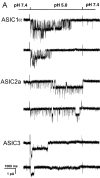





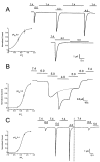
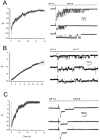
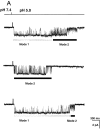



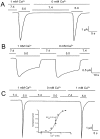




Similar articles
-
Single-channel properties of recombinant acid-sensitive ion channels formed by the subunits ASIC2 and ASIC3 from dorsal root ganglion neurons expressed in Xenopus oocytes.J Gen Physiol. 2001 Jun;117(6):563-72. doi: 10.1085/jgp.117.6.563. J Gen Physiol. 2001. PMID: 11382806 Free PMC article.
-
Mammalian ASIC2a and ASIC3 subunits co-assemble into heteromeric proton-gated channels sensitive to Gd3+.J Biol Chem. 2000 Sep 15;275(37):28519-25. doi: 10.1074/jbc.M004114200. J Biol Chem. 2000. PMID: 10842183
-
Functional characterization of acid-sensing ion channels in cultured neurons of rat inferior colliculus.Neuroscience. 2008 Jun 23;154(2):461-72. doi: 10.1016/j.neuroscience.2008.03.040. Epub 2008 Mar 26. Neuroscience. 2008. PMID: 18456416
-
Peptides inhibitors of acid-sensing ion channels.Toxicon. 2007 Feb;49(2):271-84. doi: 10.1016/j.toxicon.2006.09.026. Epub 2006 Oct 4. Toxicon. 2007. PMID: 17113616 Review.
-
Voltage-gated proton channels in microglia.Prog Neurobiol. 2001 Jun;64(3):277-305. doi: 10.1016/s0301-0082(00)00062-9. Prog Neurobiol. 2001. PMID: 11240310 Review.
Cited by
-
Gating of acid-sensitive ion channel-1: release of Ca2+ block vs. allosteric mechanism.J Gen Physiol. 2006 Feb;127(2):109-17. doi: 10.1085/jgp.200509396. Epub 2006 Jan 17. J Gen Physiol. 2006. PMID: 16418400 Free PMC article.
-
Bile acids potentiate proton-activated currents in Xenopus laevis oocytes expressing human acid-sensing ion channel (ASIC1a).Physiol Rep. 2017 Feb;5(3):e13132. doi: 10.14814/phy2.13132. Physiol Rep. 2017. PMID: 28193786 Free PMC article.
-
Physiological insight into the conserved properties of Caenorhabditis elegans acid-sensing degenerin/epithelial sodium channels.J Physiol. 2023 May;601(9):1625-1653. doi: 10.1113/JP283238. Epub 2022 Oct 23. J Physiol. 2023. PMID: 36200489 Free PMC article.
-
Extracellular acidosis activates ASIC-like channels in freshly isolated cerebral artery smooth muscle cells.Am J Physiol Cell Physiol. 2010 May;298(5):C1198-208. doi: 10.1152/ajpcell.00511.2009. Epub 2010 Feb 24. Am J Physiol Cell Physiol. 2010. PMID: 20181928 Free PMC article.
-
Accelerated Current Decay Kinetics of a Rare Human Acid-Sensing ion Channel 1a Variant That Is Used in Many Studies as Wild Type.Front Mol Neurosci. 2019 May 24;12:133. doi: 10.3389/fnmol.2019.00133. eCollection 2019. Front Mol Neurosci. 2019. PMID: 31178694 Free PMC article.
References
-
- Akopian, A.N., C.C. Chen, Y. Ding, P. Cesare, and J.N. Wood. 2000. A new member of the acid-sensing ion channel family. Neuroreport. 11:2217–2222. - PubMed
-
- Askwith, C.C., C. Cheng, M. Ikuma, C. Benson, M.P. Price, and M.J. Welsh. 2000. Neuropeptide FF and FMRFamide potentiate acid-evoked currents from sensory neurons and proton-gated DEG/ENaC channels. Neuron. 26:133–141. - PubMed
-
- Babinski, K., S. Catarsi, G. Biagini, and P. Séguéla. 2000. Mammalian ASIC2a and ASIC3 subunits co-assemble into heteromeric proton-gated channels sensitive to Gd3+. J. Biol. Chem. 275:28519–28525. - PubMed
-
- Baron, A., L. Schaefer, E. Lingueglia, G. Champigny, and M. Lazdunski. 2001. Zn2+ and H+ are coactivators of acid-sensing ion channels. J. Biol. Chem. 276:35361–35367. - PubMed
Publication types
MeSH terms
Substances
Grants and funding
LinkOut - more resources
Full Text Sources
Other Literature Sources
Miscellaneous

